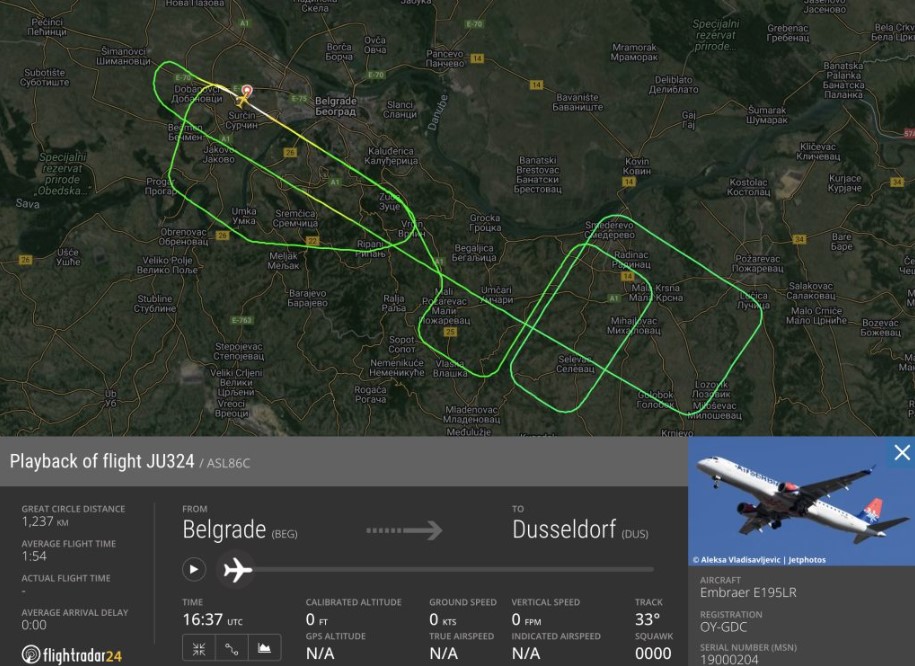A preliminary report has been published into the incident on February 22, 2024, involving a Marathon Airlines Embraer ERJ-195 operating on behalf of Air Serbia. The aircraft (registered OY-GDC) was operating a scheduled passenger service (flight number JU324) from Belgrade (BEG) to Dusseldorf (DUS) with 106 passengers and crew onboard.
The aircraft had lined up runway 30L at taxiway D5, which has a takeoff run available (TORA) of 4,135 ft (1,273m). The flight began its takeoff roll at 17:38 and subsequently overran the end of the runway before becoming airborne.
Following a collision with the approach lights and ILS antenna of opposing runway 12R, the aircraft became airborne about 1,650 ft (500m) past the runway end. The plane climbed through a height of 50 feet (15m) about 6,700 feet (2,050m) past the runway end and stopped its climb at 4,000 feet (1,219m).
The crew then elected to burn off fuel and return to Belgrade for a landing on runway 30L where the aircraft landed without further incident about 55 minutes after departure. While there were no injuries, the aircraft sustained substantial damage. Additionally, following the incident, the Instrument Landing System of runway 12R was downgraded from CATIII to CATI.
Investigation findings
According to air traffic control (ATC) recordings of the incident, the aircraft was cleared to line up runway 30L at intersection D6. However, the aircraft entered the runway at intersection D5. ATC queried the crew and cleared the aircraft to backtrack the runway to D6. The crew, however, replied they were able to depart from D5.
The aircraft subsequently was cleared to take off and began its takeoff run. Controllers in the tower subsequently observed the aircraft taking off leaving a lot of dust behind and climbing out very slowly.
Shortly after takeoff, the crew advised they needed to go back immediately, as they reported they had hit an object on departure. The tower controller acknowledged the request and instructed an aircraft already on the runway to vacate the runway.
The crew of JU324 reported they had selected full take-off thrust normal acceleration until 80 knots. However, at 100 knots they realized they were running out of runway surface. Considering the remaining runway ahead the crew decided it was safer to continue as they estimated the aircraft would soon become airborne.
The crew began to raise the nose of the aircraft in an attempt to get airborne. The aircraft began to shake as they left the runway surface and subsequently hit an object. Following the aircraft getting into the air, the crew received multiple indications of issues with several onboard systems. These included the flaps and bleed air.

After working the checklists, the crew declared a “Mayday”, adding to their transmission that they had hit an object on departure and decided to have the landing gear checked during a low pass over the airport. However, during that low pass, ground crews did not observe any issues with the aircraft’s landing gear.
Due to the flap issues, the crew decided to use a higher speed than normal for landing and landed on runway 30L without further incident. The crew taxied to the apron with emergency services following.
Back on the ground
Upon arrival on stand, ground crews quickly informed the flight crew there was a fuel leak from the left-hand wing. The crew quickly shut down the engines, while airport emergency services dealt with the fuel leak. After passengers and crew had disembarked the aircraft in the normal manner, authorities ordered the aircraft to be removed from the terminal to a safer place awaiting further inspection.
Following a visual inspection in the daylight the following morning, aircraft tire tracks were found past the end of the paved surface. It was confirmed that the aircraft had collided with several approach lights and the ILS monitoring antenna sited 45 meters past the paved surface. Some parts of the airport boundary fence were found in the wing root of the aircraft itself.
About 512ft (160m) past that concrete contact marks of the tail section of the aircraft’s fuselage were found on the ground. No traces of the aircraft’s nose wheels were found on the ground, while tracks of the main gear were found until the monitoring antenna.
Conclusions
The incident report concluded that from the evidence collected, the aircraft went past the runway end with both main gear struts carrying most of the weight and transmitting vibrations onto the airframe. The aircraft hit the monitoring antenna and its foundation with the left-hand wing.
One of the probable causes of the incident is stated in the preliminary report to have been “the inadequate assessment of take-off parameters during the pre-flight preparation of the flight crew of the aircraft, and after the decision to take off with a shorter runway length compared to the initially planned one.”
Lease agreement terminated
Following the incident involving flight JU324, Air Serbia announced that regardless of the results of any investigations that may follow, it had terminated its wet-lease contract with Marathon Airlines with immediate effect. The agreement had involved the supply of four Embraer jets to the Serbian airline by Greece-based Marathon Airlines.

Air Serbia added to its statement that any flights that were to be operated by the leased aircraft would be flown using its own aircraft, and the airline would take all steps necessary to minimize passenger disruption as a result of the switch.


2 comments
Evergreen: “Proper Preflight Planning Prevents Poor Performance.”
It is hard to believe these aviators were oblivious as to the consequences of their decisions. There might be a gap between the understanding of what one gets from a performance tool and the actual meaning is of the data and how this translates into the real world.